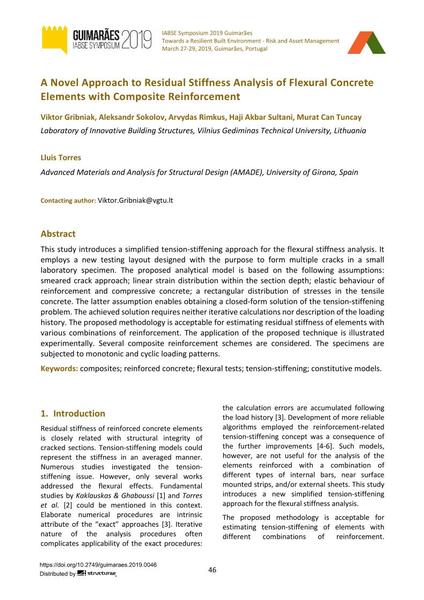A Novel Approach to Residual Stiffness Analysis of Flexural Concrete Elements with Composite Reinforcement

|
|
|||||||||||
Bibliographic Details
| Author(s): |
Viktor Gribniak
(Laboratory of Innovative Building Structures, Vilnius Gediminas Technical University, Lithuania)
Aleksandr Sokolov (Laboratory of Innovative Building Structures, Vilnius Gediminas Technical University, Lithuania) Arvydas Rimkus (Laboratory of Innovative Building Structures, Vilnius Gediminas Technical University, Lithuania) Haji Akbar Sultani (Laboratory of Innovative Building Structures, Vilnius Gediminas Technical University, Lithuania) Murat Can Tuncay (Laboratory of Innovative Building Structures, Vilnius Gediminas Technical University, Lithuania) Lluis Torres (Advanced Materials and Analysis for Structural Design (AMADE), University of Girona, Spain) |
||||
|---|---|---|---|---|---|
| Medium: | conference paper | ||||
| Language(s): | English | ||||
| Conference: | IABSE Symposium: Towards a Resilient Built Environment Risk and Asset Management, Guimarães, Portugal, 27-29 March 2019 | ||||
| Published in: | IABSE Symposium Guimarães 2019 | ||||
|
|||||
| Page(s): | 46-51 | ||||
| Total no. of pages: | 6 | ||||
| DOI: | 10.2749/guimaraes.2019.0046 | ||||
| Abstract: |
This study introduces a simplified tension-stiffening approach for the flexural stiffness analysis. It employs a new testing layout designed with the purpose to form multiple cracks in a small laboratory specimen. The proposed analytical model is based on the following assumptions: smeared crack approach; linear strain distribution within the section depth; elastic behaviour of reinforcement and compressive concrete; a rectangular distribution of stresses in the tensile concrete. The latter assumption enables obtaining a closed-form solution of the tension-stiffening problem. The achieved solution requires neither iterative calculations nor description of the loading history. The proposed methodology is acceptable for estimating residual stiffness of elements with various combinations of reinforcement. The application of the proposed technique is illustrated experimentally. Several composite reinforcement schemes are considered. The specimens are subjected to monotonic and cyclic loading patterns. |
||||
| Keywords: |
tension-stiffening reinforced concrete constitutive models flexural tests composites
|
||||
